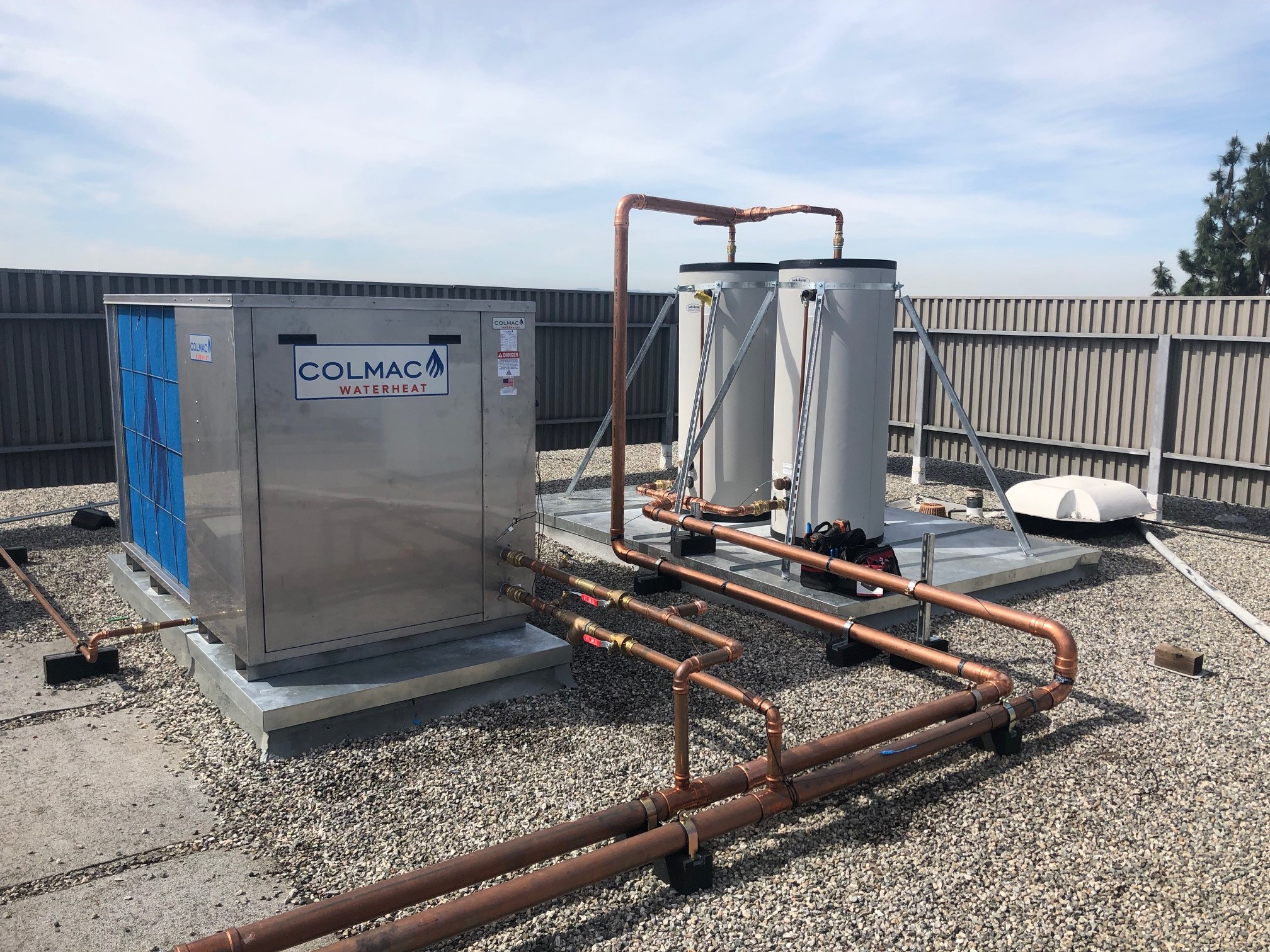As California looks to achieve carbon neutrality by 2045 through decarbonization and electrification, it’s essential we all find the right technologies that will help us get there. Heat pump water heaters (HPWH) are a newer, yet key, technology in California’s building decarbonization effort. And while HPWHs are a newer technology, heat pumps are basically air conditioners running in reverse—the technology is stable, commercial and widely-used in Asia.
How the Technology Works
HPWHs use electricity to move heat from the surrounding air into the water to make it hot for showers, sinks, and other domestic uses. In contrast, traditional domestic hot water boilers heat up water by burning natural gas which emits greenhouse gas emissions. By moving heat with HPWHs instead of generating heat with a boiler, hot water is produced more efficiently and without polluting the atmosphere.
The Evolution of the HPWH
 A useful analogy for current central HPWH retrofit installations is the evolution of an electric car. Initially, all cars were powered using fossil fuels requiring gasoline station infrastructure. The next generation saw hybrid cars like the Prius which used both gasoline and electricity requiring the installation of garage electrical outlets. Finally, fully electric vehicles (EV) like the Volt or Tesla run entirely on electricity, requiring EV charging station infrastructure. In this scenario, gas stations are no longer needed but additional electrical capacity is needed for electrical charging stations.
A useful analogy for current central HPWH retrofit installations is the evolution of an electric car. Initially, all cars were powered using fossil fuels requiring gasoline station infrastructure. The next generation saw hybrid cars like the Prius which used both gasoline and electricity requiring the installation of garage electrical outlets. Finally, fully electric vehicles (EV) like the Volt or Tesla run entirely on electricity, requiring EV charging station infrastructure. In this scenario, gas stations are no longer needed but additional electrical capacity is needed for electrical charging stations.
Central domestic hot water HPWH retrofit installations are currently in the hybrid vehicle stage. Historically, domestic hot water was provided by traditional fossil fuel boilers requiring natural gas lines to be plumbed to all properties. Now, the industry has evolved into a hybrid configuration: the HPWHs serve as the primary source for heating hot water and the existing natural gas boilers are used as a secondary source. Keeping the existing boiler allows for a smaller HPWH which has a more favorable return on investment for owners taking into account operational efficiency, annual savings, and initial costs.
As of March 2019, Bright Power has successfully designed and retrofitted 8 hybrid central systems at multifamily buildings in California over the last few years. With more HPWH hybrid systems installed and tested, the technology and design advances are paving the way for 100% electric central systems in the future.
HPWH technology is new to the U.S. but ubiquitous in Japan and other markets throughout Asia. As such the manufacturing base for this technology already exists and is well-positioned to serve the U.S. market. You can find heat pump technology in many other applications in buildings—refrigerators, air-conditioning units, and anything with a compressor or refrigerant is by definition a heat pump; what’s “new” is the application of heat pumps for water heating.
Economics, Maintenance and Integrating with Existing Buildings
Initial capital costs of HPWH retrofits are more expensive than replacing in-kind, but current incentive programs such as the Low-income Weatherization Program generally make these retrofits cost-effective. Since the installation of HPWH-natural gas hybrid systems is more recent, there is limited data on the total cost of ownership.
In terms of operations and maintenance, the HPWHs are intended to last 15-25 years with low maintenance requirements. And in many cases, existing HVAC and/or plumbing contractors are well-positioned to service the fittings, compressors, and refrigerants. Generally, owners should expect an increase in electricity costs but a significant decrease in gas consumption, resulting in a small annual energy cost savings. Overall, hybrid central HPWH systems tend to be a good fit for buildings with at least 50 units, a high natural gas rate, and a low electricity rate.
While HPWHs are readily available and can be used in new and existing buildings, they are not a drop-in replacement for traditional boilers. Some important considerations include electrical capacity and ensuring sufficient air circulation around the heat pump. HPWHs need a constant supply of warm air for heat transfer and a path for the cold air to exhaust outside or into an adjacent space to avoid freezing the HPWH. Not all properties are an ideal fit for the technology, and all installations require an installer who has proven experience with the technology.
Building for the Future
California is on a path to a cleaner, decarbonized future. To get there, proven and innovative technology like HPWHs is a must. If you have yet to explore how they could work for your portfolio, now is the time! Between the attractive incentive programs that decrease your payback period, low maintenance requirements, and the ability to get California closer to carbon neutrality, HPWHs are here to stay.
Reach out to our experts if you want to learn more about heat pump water heaters.